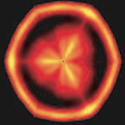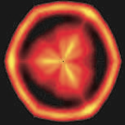A flattened cone
A three-dimensional topological insulator is a bulk insulator with robust, “topologically protected” conducting states on its surface. The surface states form a two-dimensional electron gas of “massless” Dirac fermions, like those in graphene, and support a quantum Hall state in a high magnetic field.
While this two-dimensional electron gas behavior is reminiscent of that in graphene, the surface states of a topological insulator should be more robust. This feature, which could be promising for designing devices that transport spin without heat dissipation, is tied to the fact that the Fermi surface of a topological insulator consists of an odd number of Dirac cones.
, a well-known thermoelectric material, has recently been touted as a three-dimensional topological insulator when doped with a light nonmagnetic element, like magnesium. Now, writing in Physical Review Letters, Kenta Kuroda and colleagues at Japan’s Hiroshima University, in collaboration with researchers at other institutions in Japan and Spain, report new photoemission measurements that map out the electronic states on the surface of magnesium-doped . Challenging the general belief that the electrons in form perfect Dirac cones, they find that there is a hexagonal deformation in the cone far from the Dirac point.
The presence of such a deformation opens the possibility that spin-density waves, which are forbidden for ideal topological insulators, form in . The result also demonstrates that could, with appropriate doping, be a candidate material for quantum topological transport—a form of dissipationless transport that occurs when the electronic states are protected by time-reversal symmetry. – Daniel Ucko





